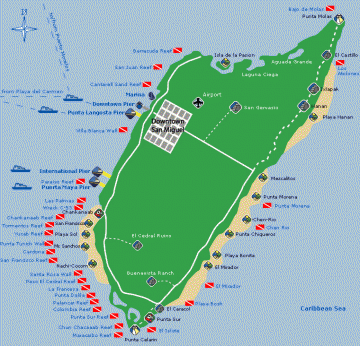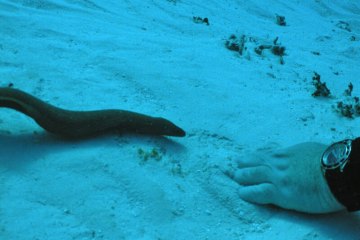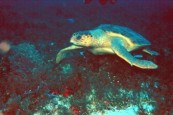When considering where to dive, it is important to understand just how large some of the reef systems can be and how one section might connect with another. One can easily make three different dives in an area called Columbia Deep and never see the same coral. The southern section of Columbia Deep borders on what is known as Punta Sur (South Point) and offers some of the best diving available in the resort area. At Columbia Deep divers find towering coral that rises from a bottom ranging from 90 to 200 feet to within 50 feet of the surface scattered over a sandy bottom along with impressive sponges, caves and tunnels. It is not unusual to encounter spotted eagle rays, turtles, nurse sharks and large groupers here. In general, there is an abundance of reef fish unusual at such depths.
Speaking of Punta Sur, due to the distance, some dive operators may require a slightly higher fee for trips here. In addition, because of the depth and necessity for good buoyancy control, many will want to see clients dive at least once before taking them here. Along with the chance to see some big fish and impressive topography, the main attraction is a cave system including a section called “Devil’s Throat.” In the course of running this section, divers penetrate a large dark room, slide over a ledge and wind their way down to an exit at about 125 feet. This is an excellent advanced dive.
Nearby, Columbia Shallow is a very shallow dive ranging from 20 to 35 feet with lots of color and fish life. It is not what would be considered a challenging dive, but more of a stroll through a lovely park. Because this site is so far south, it doesn’t fit into the typical pattern of making your shallow dive north of your first dive and as a result, doesn’t get a lot of diver activity. There is some speculation that black tip sharks use this area as a nursery as evidenced by occasional sightings of juveniles. A dive at Columbia Shallow may require some pre-arranging with the dive shop. If you are able to make Columbia Shallow your second dive, ask your dive master or boat captain to show you the nearby shallow sandy area. It makes a great spot for spending your surface interval.
Most first time divers visiting Cozumel come wanting to dive Palancar. This is the best known Cozumel reef and another example of the enormous size of some of Cozumel’s dive sites. What is known as Palancar is actually a series of reefs that would require several days to explore. Few places in the world offer relatively safe dives for beginners yet present the beauty of Palancar Caves and the shallower Palancar Gardens. These two dives offer something for all levels of skill from the beginner to the most experienced diver. Gentle currents are the rule here, allowing the sensation of drift diving and a brief exposure to “The Wall” without the danger you might find in a faster flow. These reefs can be dived enjoyably from 50 to 90 or more feet and therefore lend themselves to multi-level dives. During certain seasons, literally clouds of small mixed “silver sides” can be found in some of the caves at both sites. On some deeper dives in the general vicinity, many experienced dive masters will end the dive making the safety stop over top of the Gardens, which reach up to within 25-30 feet of the surface.
Some parts of the shallower portion of Palancar Horseshoe are full of broken coral and little fish life. However, other sections of the area known as Little Horseshoe present a winding maze of pristine pinnacles that rise from a depth of over 100 feet and top out at around 30 feet from the surface. And for the advanced diver, the little dived wall at Horseshoe can be outstanding.
Another lesser-dived area just north of Palancar that is inviting for experienced or a novice diver is Dalila. Rather than the giant structures found further south, this reef offers a series of low profile coral with overhangs, caves and a wide variety of fish. In a single dive here, it is possible to find numerous varieties of butterfly fish, angel fish, trunk fish, file fish, ocean and queen trigger fish, splendid toad fish, green turtles, large barracuda, African Pompano, amber jack and resting nurse sharks.
One of the most visited dive sites in Cozumel is the Santa Rosa Wall. Many divers have made multiple dives there and never found more than a gentle current. They surface raving about the beauty of the wall, the towering coral, the large sponges and small caves. However, as reported on some online chat groups, in print and from this writer’s personal experience, the current at Santa Rosa can sometimes be dangerous.
Make sure your dive master jumps into the water first to check the current. Most dive masters will routinely do this at all dive sites in Cozumel but it is especially important at Santa Rosa. And if your dive master comes back to the boat and says you need to move on to another site, don’t argue the point. While there is always some current here, it is usually very manageable. However, in the worst conditions, even an experienced diver can find it difficult to maintain their depth.
Interestingly, one of the tip-offs that there is a dangerous current at Santa Rosa is the water above the wall appears flat (but with small ripples) while nearby water is choppy.
Because Santa Rosa is the wall dive nearest to the resort area, dive masters that are most interested in “getting out and getting back” will attempt to suggest this as your first dive every time out. While it is an interesting dive that anyone might enjoy the first time, there is too much to see in Cozumel to dive Santa Rosa more than once in a week long trip.
San Francisco Wall is a good choice for a novice diver’s first exposure to a wall dive. Just south of the San Francisco Beach club, you will find a ridge of coral running parallel to the shore along the top of a gently sloping wall starting at about 50 feet. While the wall obviously goes deeper, the best coral is at 65 feet or above so this can be an enjoyable yet shallow wall dive. Expect to see lots of fish, lobster, crab, lush coral, sponges and an occasional turtle.
Just north of San Francisco is the shallow Caradona Reef. It is a low profile system with broad flat reefs full of holes and crevasses where a variety of creatures hide. It is possible to spot sleeping nurse sharks by looking through holes from the top of the reef or underneath an overhanging ledge.
Punta Tunich is another excellent shallow dive in the same general area. You will find a very quick current over some colorful low profile coral and lots of fish. At Tunich, be sure to stay behind your dive master. There are several holes with protective overhangs that he will drop into attempting to locate some large green moray eels. If you’re in front of him when he drops, you’ll find it a difficult swim back against the current.
Flying with the current, it doesn’t take very long to run the length of Tunich. Many dive masters will drop into Tunich at a point prior to the green moray eel hole, and when the bottom begins dropping away, turn right and swim across a sand and grass bottom for about five minutes. While there is little in the way of coral or colorful vegetation over this sandy bottom, stay alert for sightings of some fish species unusual for Cozumel.
On one such trip, we were thrilled to see a pair of Coronet Fish, a close relative of the much more common Trumpet Fish; but a fish that is rarely seen in Cozumel.
Eventually you will reach Yucab, where the current is always present but almost always calmer than at Tunich. You’ll also find lots of overhangs and crevices to explore. A large number of ocean trigger fish hang out here, as do solitary barracudas and some very large sheep heads.
Tunich is usually made as a shallow dive of 55 to 65 feet but, in fact, you are traveling down the top and just inside another dive site known as the Virgin Wall, which in turn leads to an area known as Yucab Wall. As the name implies, because of the swift current that can sometimes blow away from the wall, very few trips are made here. This is not a wall dive for novices and is best at 90 feet and deeper.
For some reason, there is not as much diver pressure at the Cedral Wall than at some less attractive dives, but in many ways this is one of the best wall dives on the island. On occasion, the current can blow a little strong and off the wall but if the diver keeps an eye on his depth and stays relatively close to the wall; it is nothing an intermediate diver can’t handle. The wall begins at around 60 feet and goes down from there. It can be a rewarding dive from 60 to 125 (or deeper) feet. At different points along this wall you might find yourself flying along a gentle slope while in other sections you will realize you are suspended over a bottom that disappears into a purple abyss. This is also a good place to make a multi-level dive moving up and down the wall and including a relatively shallow garden of coral running parallel to the divide closer to the island. While there’s no guarantee, divers often see spotted eagle rays, large grouper, crabs, lobsters, turtles and a wide variety of reef fish. There are lots of holes and crevasses in the wall as well as protected overhangs in the shallow area, ideal haunts for nurse sharks.
In the same general area is the very pretty shallow dive Paso de Cedral. Expect to see a variety of reef fish, spotted moray eels, grouper, lobster, crab and an occasional turtle. Unfortunately, the shallow coral here suffered some damage in the most recent hurricane and is not quite as nice as it used to be but if you look, you can still find post card quality with lots of openings providing framed vistas. Towards the end of this dive there are a few small caves where divers can sometimes swim through schools of glassy slippers. This site is suitable for beginners and sees a lot of diver activity
Tormentos is known for its large grouper and spotted eels. The grouper will sometimes show up as soon as divers drop into the water and on occasion will stay with groups the entire dive. The reef is a series of large flat coral heads surrounded by sandy bottom. Visibility is sometimes clouded here but overall, it’s an enjoyable 45 to 55 foot dive.
A popular shallow dive for day and night trips is the reef at Chankanaab. As you might guess, it lies just off the shore from the Chankanaab National Park. This is one of the few locations where you will usually find the current running north to south or reverse of everywhere else in the resort area. However, unless there is a storm nearby, the current won’t be very strong. Expect to see lots of miscellaneous reef fish.
There is an interesting shore dive of the openings to some caves that are home to large tarpon and silver sides inside the Chankanaab National Park. This is also a chance to experience the “green mirror” effect of fresh water from underground streams floating over top of the ocean salt water. To reach the caves, enter the water as far south in the park as possible and swim south along the shore. Eventually you will reach a large room on your left, which marks the entrance to the caves. Care should be taken not to stray too far from the entry unless you have cave certification. This is a very shallow dive of 10 to 20 feet. Tank and gear rental is available on the beach inside the park.
Just outside of the shallower Chankanaab reef is another lesser-dived area known as Chankanaab Balones. The name for this reef comes from the rounded coral heads resembling balloons that rise up out of the sandy bottom. This is an in-between depth of 55 to 75 feet, a little too deep for a non-computer second dive and really not very deep for a “deep” first dive. Also, because of its location north of most of the good shallow dives, a deep dive here limits your choice for a second dive. Visibility is usually not as good as most other sites in Cozumel but partly because of that and also the lack of diver pressure; you can sometimes experience some very close encounters with large and unusual fish.
Probably the most visited dive site in Cozumel is Paradise Reef. This is a shallow dive of 30 to 45 feet suitable for beginners. The reef is close enough to land (approximately 200 yards) to kick out for a shore dive. If you want to make a shore dive here, you will find it just north of the El Presidente hotel or Calleta Marina. There is a small dirt road that you follow north of and past the marina about 200 yards to a small shack. Just swim out perpendicular to the shore and you can’t miss it. The reef runs all the way to the Cruise Ship Pier and the current is normally gentle enough to allow you to swim in both directions without trouble.
Paradise has an abundance of fish life and is an excellent place to spot the Splendid Toad Fish, a species that is unique to Cozumel. Because of the location close to the resort area, most operators will make their night dives on Paradise. Unfortunately, the coral is beginning to show the wear of nighttime reef walking.
The top of the Villa Blanca Wall begins at about 60 feet and gently slopes away. There’s really not very much coral but there are lots of sponges and vegetation. The reef area just inside of the wall is loaded with lobster and miscellaneous reef fish including spotted drum. And its location makes it a very quick trip back to town when you’re finished.



